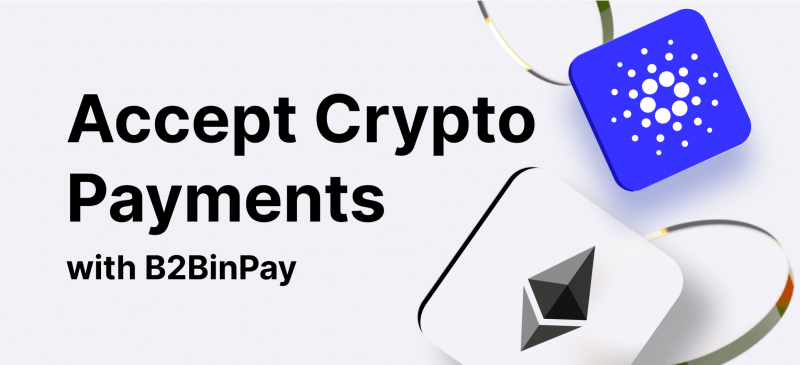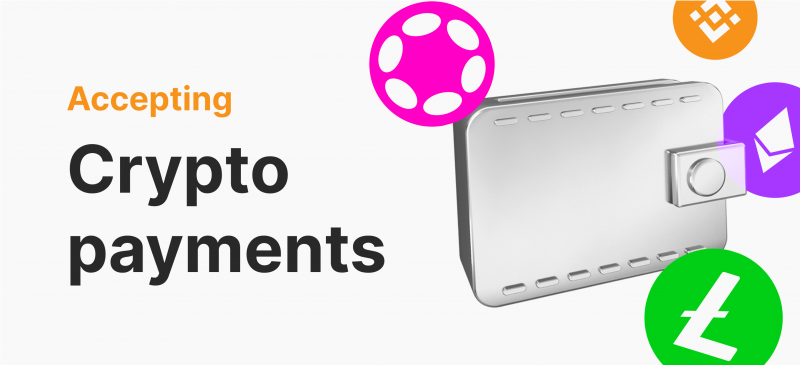Digital coins have significantly reshaped the financial terrain with their decentralised, borderless, and transparent nature. As demand for digital money increases, understanding on-ramps and off-ramps is crucial for successful navigation in the digital landscape and maximising user experience.
In this article, we will discuss the difference between on- and off-ramps, discover their types and benefits, and explore factors to consider when selecting a crypto-fiat platform.
Key Takeaways
- The crypto on-ramps method enables the conversion of fiat money into digital assets.
- The crypto off-ramps method is opposite to on-ramps and converts cryptocurrency into fiat.
- Security and trustworthiness are crucial factors when choosing on- and off-ramp platforms.
Explaining Crypto On-Ramp
An end-to-end crypto ramp solution is a simplified and optimised exchange mechanism that bridges the gap between crypto and fiat, facilitating seamless transactions between these two distinct economic paradigms in a unified, unbroken experience.
Crypto on-ramps are digital services that facilitate the seamless conversion of fiat money into virtual money, allowing users to enter the crypto world from traditional fiat currencies or other digital assets.
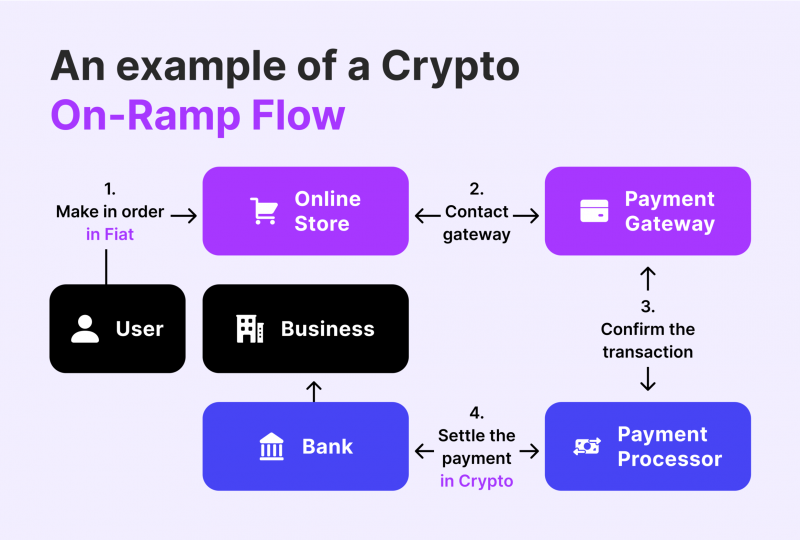
Crypto on-ramping is used to exchange fiat money for cryptocurrency and involves various forms of transactions.
How Does It Work?
The crypto on-ramp solution allows users to purchase crypto in three simple steps.
- Users must specify the order details, such as currency pair and fiat money amount, and contact details, such as the user’s email address.
- The on-ramp service requires users to undergo a KYC (Know Your Customer) verification process, which typically requires an ID card and liveness check.
- Once verification is completed, users can make a payment, with the total sum displayed during the first step.
After completing these steps, users may wait a few minutes to several hours for the crypto to arrive, depending on the chosen exchange service.
For users who have already used the exchange service, this process is faster as there is no need to go through the second step, which can be time-consuming and take up to 30 minutes. This process is easier for users who have already used the exchange service.
On-Ramp Types
There are several main types of on-ramps in the crypto space: centralised exchanges, peer-to-peer platforms, payment processors, crypto ATMs, and NFT platforms.
CEXs are straightforward, offering a wide range of cryptos and advanced trading features for beginners and seasoned traders. Trading with CEXs requires KYC verification as a security measure to guarantee that your identity is not fake. Centralised exchanges like Coinbase and Binance allow users to create accounts, deposit fiat, and purchase crypto, while some platforms use APIs to integrate with DEXs.
P2P platforms, on the other hand, directly connect buyers and sellers, eliminating the need for a centralised intermediary. They support various payment methods and offer greater privacy but can be susceptible to scams or fraudulent activities.
Payment processors allow large companies to accept cryptocurrency payments, serving as an excellent crypto on-ramp for customers.
Digital coins ATMs facilitate fiat-to-crypto transactions, allowing users to purchase blockchain currency with fiat currencies, debit, or credit cards.
NFT platforms offer credit card payments as an alternative method for entering the crypto ecosystem, where NFTs serve as the entry point into the crypto world.
All types of on-ramps offer a variety of trading options and are suitable for both beginners and seasoned traders.
Benefits and Drawbacks
Fiat on-ramp crypto solutions offer several advantages for users.
Thus, CEXs offer real-time market data and analytical tools, enabling users to make informed decisions.
Another benefit is the simplicity of the purchasing process. While initial users must deal with registration and KYC verification, experienced users can skip this stage and buy crypto quickly. Most fiat on-ramp crypto solutions come with built-in anti-fraud and KYC tools, protecting users and businesses from fraudulent activities.
However, on-ramp platforms also require users to trust their security measures and charge fees or markups on cryptocurrency rates to generate revenue. P2P platforms, while offering enhanced privacy and control, may present challenges in terms of liquidity and limited currency options, particularly for exchanging less popular digital tokens.
Crypto on-ramps turn fiat money into digital currencies, while off-ramps convert these currencies back into fiat, essential for digital financial transactions.
Explaining Crypto Off-Ramp
Unlike on-ramping, which involves users converting their fiat money into crypto assets, a crypto off-ramp is a reverse process that allows users to exchange digital coins for traditional fiat money, such as dollars or euros. It acts as a bridge between the world of DeFi and the world of traditional finance, enabling users to use their crypto assets for everyday tasks.
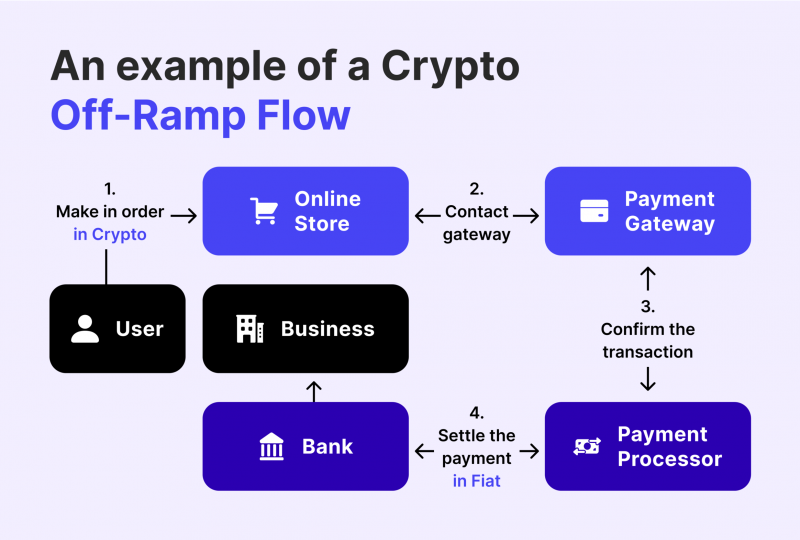
Fiat off-ramp provides a convenient way to convert digital assets into traditional currency. Typically, people transfer their digital currency from a crypto wallet or exchange to a bank account, credit card, or some other means to convert it into fiat money. Through off-ramps, it is possible to exchange crypto for tangible assets and spend them then in the physical world.
How Does It Work?
The general working flow of modern crypto off-ramps consists of three steps.
- A user sets up a selling order, specifying the currency pair (crypto to sell and fiat to receive) or the expected amount of money.
- A user inputs card details such as first and last name, IBAN, and beneficiary address.
- A user sends crypto to a designated wallet address, and upon receipt, the corresponding fiat currency is dispensed to the user’s chosen withdrawal method.
This process is completed when a user converts their cryptocurrency to fiat money.
Off-Ramp Types
Crypto off-ramps can be achieved through various methods, including exchange crypto off-ramps, peer-to-peer off-ramps (P2P), purchases and payments, crypto debit cards, payment processors, and crypto ATMs.
Exchange crypto off-ramps are very common and widespread and can be found on CEXs.
P2P fiat off-ramp involves buyers purchasing crypto assets in exchange for fiat currency. Another option to achieve P2P off-ramping is direct negotiations, but this is considered very risky.
Purchases and payments are another way to off-ramp digital currency. Cryptocurrency will not necessarily be converted to fiat currency but rather to tangible assets, as crypto acceptance varies across countries.
Some on-ramping platforms provide crypto debit card options for users to load their crypto assets and employ them for purchases, using a debit card as a middleman.
Some payment processors allow businesses to accept virtual coins as payment and automatically convert them to fiat currencies.
Crypto ATMs with on-ramping often provide off-ramping services. It is important to note that off-ramping crypto may not be as easy as using an exchange, as it is still a way to manage the acceptance and adoption of crypto.
Benefits and Drawbacks
Crypto off-ramps offer advantages for users who need to access traditional financial systems or engage in activities requiring fiat currency. Off-ramps allow users to convert their crypto holdings into tangible funds without complex processes, encouraging widespread adoption of cryptocurrencies as a viable alternative.
However, there are disadvantages to consider, such as transaction fees and processing times, regulatory requirements for identity verification and compliance, and the volatility of cryptocurrencies. Additionally, not all merchants accept cryptocurrency payments, limiting the practicality of crypto debit cards in certain locations.
On-Ramp vs Off-Ramp
On-ramps and off-ramps serve as access points for individuals to enter and exit the digital financial realm. On-ramps provide a convenient way for individuals to exchange fiat currency or digital assets for cryptocurrencies. This simplifies the process for new users to engage with the realm of digital currency.
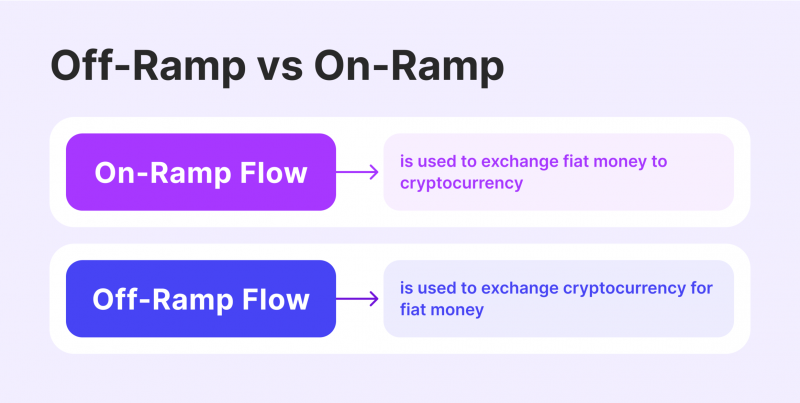
Off-ramps, on the other hand, allow crypto holders to convert their digital assets back into traditional fiat currencies or other tangible forms, allowing users to engage in transactions outside the digital world.
On-Ramps and Off-Ramps: How to Choose?
Crypto on/off-ramp services in crypto are still being developed, with unclear laws and regulations, and the security of these transactions depends on the chosen method. To ensure a secure experience, choose reputable platforms with proper authentication features, encryption protocols, and security audits.
Consider several factors when choosing the best crypto off-ramp and on-ramp solution for your cryptocurrency journey. First, ensure the platform’s protective measures and name are strong. Research the platform’s history of security breaches or incidents to build confidence in its reliability.
Select a platform that supports the specific digital coins and real-life money you plan to trade or convert. This will increase your options and flexibility in managing digital assets.
Reputable platforms must follow KYC and AML procedures. However, some users may prefer venues with simpler security verifications that request less personal information. Determine the best balance between security and maintaining privacy that suits your preferences and tolerance for risk.
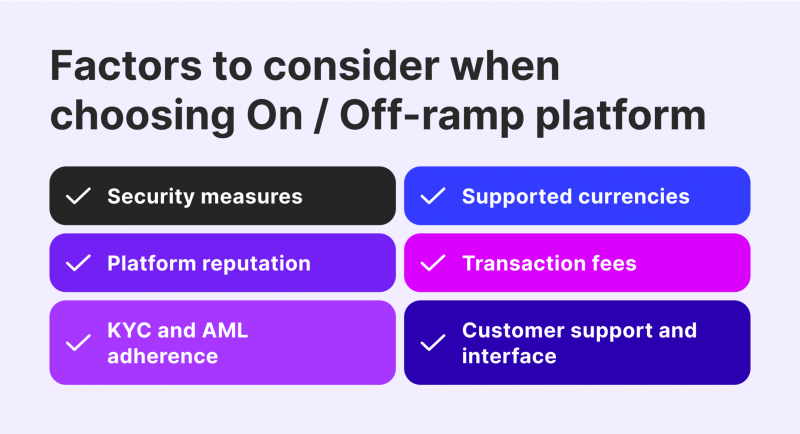
Consider the impact of transaction fees on your trading or conversion strategy, especially if you engage in frequent transactions or plan to convert large amounts of crypto coins. Some platforms offer competitive fees for trading, while others charge higher fees for convenience.
Lastly, consider the intuitive interface and customer support. An easy-to-understand interface can enhance your experience with a platform, while comprehensive customer support can be helpful if you experience some transaction issues.
Conclusion
Crypto on-ramps serve as entry points for users to convert fiat money into virtual coins. In contrast, crypto off-ramps facilitate the seamless conversion of digital assets back into fiat currencies. Both options are crucial for individuals participating in crypto-related transactions.
On-ramps and off-ramps are relatively new methods in the digital finance world; therefore, it is vital to consider security options and customer reviews when choosing a platform for crypto-fiat transactions.





